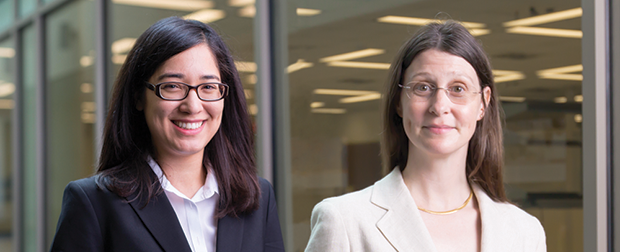Richmond, Va (December 5, 2016) - A team of Virginia Commonwealth University computer science and nanomedicine researchers in the School of Engineering is harnessing the power of machine learning to make it easier to advance research in the rapidly growing field of nanotechnology.
As more newly engineered nanomaterials—at the scale of 100,000 times smaller than the thickness of a sheet of paper—are being created and tested, the volume of research literature has skyrocketed.
“It’s hard to keep 200 papers in your head,” said Bridget McInnes, Ph.D., assistant professor in the Department of Computer Science. Researchers are finding it increasingly difficult to keep up with new findings, she said. That’s where natural language processing comes in, helping to automate the extraction and cataloguing of relevant information from massive amounts of text.

Pictured above: Left - Nastassja Lewinski, Ph.D. Right - Bridget McInnes Ph.D.
McInnes and Nastassja Lewinski, Ph.D., assistant professor in the Department of Chemical & Life Science Engineering (CLSE), formed the data science and informatics lab to develop tools and algorithms to support research discovery in the 21st century. Some of the students involved are part of the Vertically Integrated Projects program, through which undergraduate students team up with graduate students, postdoctorate fellows and faculty over several semesters.
Lewinski said the lab can help researchers discover new connections within the literature. This could help speed up the painstaking process of reviewing research, leading to achieving advancements more quickly. “The drug development process takes already, 10, 15 to 20 years,” Lewinski said. “Where can you save time?”
With both departments working together, the computer can generate information that CLSE researchers use in their lab. “Developing these tools is integral in allowing biomedical researchers to quickly extract, catalog and analyze new information for the advancement of science,” McInnes said.
For instance, Lewinski said nanoparticles called gold nanoshells—microscopic balls made of gold-encased glass—can be manipulated so that laser treatment is applied only on the diseased tissue and not the normal tissue. The computer can rapidly identify within the literature how these nanoparticles have been synthesized and their biological effects to inform further research in this area.
